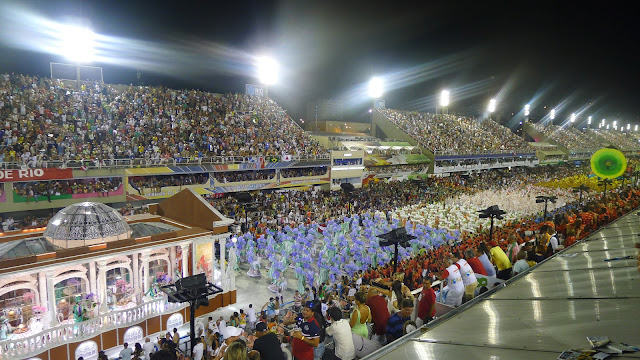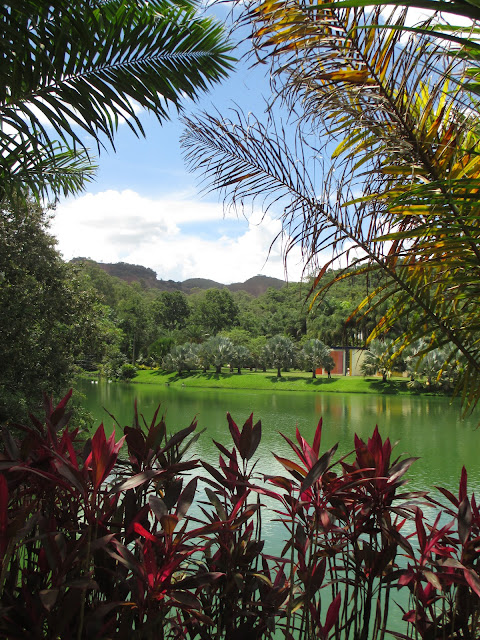Carnival = 1. over indulgence
to the point of mania 2. ice-cold beer in hand from 8am in the blazing sun,
shuffling around after a marching band in ridiculous costume 3. reversing roles, forgetting the grind of
everyday life, fantasia in every sense of the word. 4. Severe leg ache.
It is said that life in Brazil begins after Carnival. This
is not the entire truth - Carnival requires at least two months preparation and
a month’s recovery time. For some, the entire year revolves around this one
week of folia.
Sambodromo - the ‘Official’ Carnival
Samba in Rio de Janeiro is not just a dance to show off the
beautiful contours of the Big Brazilian Butt: it is a competition, an art form
accessible to all and understandable on multiple levels. It has as many
leagues, teams and divisions as the UK football league. The twelve principal
schools in the Especial league have up
to five thousand people in them. These are divided into sections: the bateria drumming section, singers and cavaquinho players, different themed alas all with unique dress and
choreographies, the passistas who
dance samba on floats and of course
the Carnival queen, often dressed as a bird, who has her own enclosure to strut
her stuff. They are often based in the favelas and
have very much of a social function, uniting thousands of people who volunteer their time to create Brazil's most impressive spectacle.
The Samba schools of Rio de Janeiro rehearse throughout the whole
year in preparation for their fleeting moment of limelight in the Sambódromo, the mammoth 125,000 capacity
stadium dedicated to Carnival parades. Not surprisingly, a samba school of this
size employs vast quantities of people and is as competitive and lucrative a business
as any. Carnivaleiros, or the
designated Carnival Engineers, are
employed throughout the year to plot the enredo
(synopsis) of their school’s parade, working closely along with set
designers and choreographers.
I was lucky enough to visit the Samba City, a vast area near
the port in Rio de Janeiro which houses the warehouses of all 12 of the Samba
schools in the liga especial. Although
visits to the city square (which occasionally houses samba events) are
sometimes permitted, visiting the individual samba schools is usually
out-of-bounds. After all, many elements of the parade are kept in utmost
secrecy until the night itself. However,
I had a friend of a friend who worked for Imperatriz samba school and I was given a tour of the place. It was literally
a carnival machine – costumes piled up everywhere, women hunched over sewing
machines making industrious quantities of costume; men sawing wood for the
floats. If the final product hadn’t been Carnival, an event which serves the
entire community, I would have assumed that working conditions were worse than
those of a sweatshop.

Adding the finshing touches to a Tapir for the Amazonian float
Amazonian costumes, Imperatriz. Similar costumes were stashed in their thousands throughout the warehouse.
Although not visible from afar, when I visited the Samba Factory and
was able to climb up on the floats the amount of detail on these floats
was astonishing. The float above depicts the indigenous markets of Para, North Brazil, and
had real coffee beans, peppercorns and artisan products in woven
baskets.
And here is the Imperatriz samba school when it finally hit the Sambodromo:
The colonial theatre parading down the Samba Motorway
A Giant Indian. If you look closely you can just about spy those costumes from the samba sweat-shop.
Although the general themes of each samba school are known long before the actual carnival, the details of the plot synopsis and floats remain enshrouded in mystery until the night itself (for the Sambodromo only occurs at night – it is a sambamarathon from 9pm until 6am). Competition between the schools can be fierce, and leads to some dirty politics. After all, anything which smells of money in a favela will most probably have the support of the local drug barons.
The sponsors of the Samba schools are as diverse as they are
unexpected. It is often a chance for both Brazilian regional and international
governments to boost tourism. Last year União da Ilha dedicated their entire parade to London (oh little did we
Londoner’s know it), with the chorus being:
Vou botar molho ingles na
feijoada
Misturar chá com cachaça
Ser ou não ser, eis a questão
Tem choro e riso nesse palco de ilusão
Which
translates as the following:
I’m going
chuck English Sauce on the feijoada *
Mix tea with
cachaça **
To be or not
to be, that is the question
There are
tears and laughter on this stage of illusion
*a stew with black beans and meat. Originated as a stew of
masters’ leftovers eaten by slaves, and is now a dish of national pride
** Brazilian spirit made from sugar cane. Great to make
caipirinhas.

Listen to the samba and watch extracts from the parade here.
It is quite amusing to see our Queen's faithful guards wiggling their bums.
This year was full of the bizarre themes as usual. Zona Sul devoted the parade to the melodramatic world
of the Brazilian soap opera, whilst Unidos
da Tijuca was stuck with the slightly more square theme German ‘civilisação’,
which featured an overflowing float of moving beer-people and another full of
sausage-people were certainly highlights.
The Grande Rio samba school had
the most riveting theme of all: the Petrol Industry. This involved an entire
section of their parade being an oil spillage with a mountain of dead fish.
(I’m not sure that is what Shell had in mind when it agreed to sponsor the
samba school…)
Note the dead fish-ladies and the gooey mass of oil. The samba school did manage to convert the dullest theme into a frenzy of colours in the next float though:
Note the dead fish-ladies and the gooey mass of oil. The samba school did manage to convert the dullest theme into a frenzy of colours in the next float though:
My time at the Sambodromo was not without drama. I accused a
policeman of robbing my camera, then backed down as I realised that I had left
the thing at home. We then found a load of sweaty outfits in the carnival
graveyard and endeavoured to dress ourselves up to enter the Sambodromo.
However, our costumes were not appreciated in the arena. We were getting booed
at for spiking our neighbours with bird feathers and obstructing their vista,
so our costumes were swiftly taken away. I expected the parade to be just like
the carnival street parties, but it was nothing of the sort – it was very much
a viewing spectacle. Once I had entered into the sedentary spirit, the whole
evening was brought to life with colours, fireworks, drums and song. I was very
impressed by the parade, but yet at the same time struck by the absurdity of it
all. A whole year of preparation for one night of parading at snail pace down a
samba-motorway dressed as a dead fish? I’d much rather have my street Carnival,
thanks.
These costumes were rather sweaty but still provided much amusement.
Blocos da Rua, the
Rio de Janeiro Street Party
This, for me, was the real Carnival of Rio de Janeiro. My
first ‘Bloco’ experience was the week before Carnival, when a traditional
marching band called Cordão de Ouro
Preto started its trudge at 8am on a Sunday morning. Getting up at 6.30am to
put on fancy dress was somewhat surreal – after all, forced happiness in the
morning seems contrary to human nature. When we arrived, the procession was in
mid-flow, brimming with beer and merriment. Since there was no water on sale, the
only option was to plough through ice-cold beer and caipirinha ice-lollies
(deliciously refreshing, despite their potency).
Bloco 'Cordao de Ouro Preto'
Consuming the remnants of a caipirinha ice-lolly
The concept of a samba bloco
is simple: a large group of musicians dressed in ridiculous costumes playing
ridiculous music, either on a float or parading behind one in the street. It is
incredible how much amusement this provides. Every single Brazilian seems to
know the lyrics to the traditional Carnival songs, Marchinhas de Carnaval. They were not too difficult to learn. Here
is a classic:
Mamãe eu quero, mamãe eu quero
Mamãe eu quero mamar,
Dá chupeta, dá chupeta,
Dá chupeta pro bebé não chorar.
Translation:
Mummy I wanna, mummy I wanna,
Mummy I want to breastfeed
Give it dummy, Give it dummy
Give it a dummy so the baby doesn’t cry.
(Doesn’t quite have the same ring in English, but nonetheless you get the point – or lack of). Watch the Tom & Jerry version on Youtube here.
Fancy dress is equally bad in taste, so bad it's brilliant:
This TV camera-man seems innocent enough, but his crew of reporters were very quick to descend upon an unsuspecting blonde 'gringa' (below), asking somewhat innapropriate (unBritish, that is) questions.
(Doesn’t quite have the same ring in English, but nonetheless you get the point – or lack of). Watch the Tom & Jerry version on Youtube here.
Fancy dress is equally bad in taste, so bad it's brilliant:
Brazilian buddy Vitor dressed as a tramp
Oh dear oh dear oh dear
This TV camera-man seems innocent enough, but his crew of reporters were very quick to descend upon an unsuspecting blonde 'gringa' (below), asking somewhat innapropriate (unBritish, that is) questions.
Aside from the blocos which play traditional Carnival music from all over Brazil (Samba and Marchinhas de Carnival from Rio, Axé and Maracatu from Salvador de Bahia), there are blocos of everything you can possibly imagine. Many of these have ingenious names: Block ‘n’ Roll, Pode vir que ta legal (You can see that it’s cool), Que merda e essa (what shit is this), Vai tomar no Grajaú (shove it up your Grajaú), Nova Geraçao de Zumbi (new generation of zombies). There was even a Super Mario bloco.
Of the many
street blocos I went to, the one that
most stands out was “Bloco de Sargento Pimenta”, a samba bloco which played
nothing but Beatles numbers. Over 100,000 people flocked to the Flamengo beach
to see the bloco, and the crowd was euphoric. I am glad that I finally got a
taste of Beatlemania, despite being born a generation too late.
I played in
a Carnival bloco myself – Bésame Mucho, a newly formed Latin-American bloco
which played classics such as Guantanamera and La Bamba. We paraded at 10am on
Sunday morning, marching down the cobbled streets of Santa Teresa with a jolly
little following.
Carnival in
Rio was exuberant and exhausting. The blocos have merged into an an almighty joyous beer-filled blur. A week’s recovery in the mountainous
region of Minas Gerais, where Brazil’s best food, cachaça and waterfalls are to
be found, was much needed.
Here are the highlights:
Belo Horizonte (the capital of Minas Gerais state) at night. The city has almost 3 million people, and it's suburbs seem to spread out forever.
A capibara hanging out by the edge of the lagoon. For those of you who are unfamiliar with this creature, it is the largest rodent in the world and looks like a giant guinea-pig.
 Celebratory acai - the best thing about Brazil by far. I have acai almost on a daily basis. It is made out of a berry which grows in the Amazon region and is supposed to have incredible qualities. Apparently it is an aphrodisiac as well...
Celebratory acai - the best thing about Brazil by far. I have acai almost on a daily basis. It is made out of a berry which grows in the Amazon region and is supposed to have incredible qualities. Apparently it is an aphrodisiac as well...
This little fellow popped over to say hello at breakfast time in the hostel at Ouro Preto. Mr Toucan rather liked papaya.
A big friendly statue in the middle of the countryside. This man is a folk hero from the region, although nobody could tell me his story.
"How the hell are we going to get over that hump?" Inspecting the route on way to our destination Tabuleiro, 5 hours drive north from Belo Horizonte.
Perhaps the most tasty meal of Brazil I have had so far - chicken, feijao (beans), farofa (yellow powdery stuff made out of mandioca flour), rice, potato, aubergine and salad. Accompanied with pineapple and basil smoothie and a complementary glass of home-made cinnamon cachaca.
Old men from Minas sitting smoking pipes on their doorsteps.
The triumphant three - Alex, his brother Ricardo and myself at the end of our 2-day long road trip to the Tabuleiro waterfall.
Here are the highlights:
Alex serving himself at his family's restaurant of Minas cuisine. I met Alex three years ago travelling in the North of Brazil, and we travelled for a week on motorbike. He routinely does crazy adventure motorbike trips of over 2000km. He let me drive for a bit - I only crashed it once... check out his blog here.
The first of many Minas waterfalls that I swam in.
Alex and his baby. Riding on the back of a motorbike along red dusty roads is very fun.
Funky palm tree at Inhotim art gallery. This was the best ever gallery I have been to. The exhibits were strategically placed in acres upon acres of botanical gardens, creating a stunning interplay between the art of nature and that of man. My favourite exhibit was gallery consisting of many interactive art installations. One room had a swimming pool in the dark with lights reflecting off the water and Stockhausen music playing full blast, another was room full of hammocks with images and music from Jimmy Hendrix projected on the walls, and another room was stuffed with balloons. Not quite sure what the purpose of the balloons was, but it sure brought out the child in me.
I want one.
Inside this gallery was a wall stuffed with dead meat.
This was brilliant. A red room. In the corner of a room was a tunnel, and at the end of the tunnel was this:
Stunning grounds. I was utterly disappointed to find out that the water had colouring in it.
A lovely evening cycling around Belo Horizonte's lagoon. BH is the capital of Minas Gerais, and is a pleasant city- it seemed much more relaxed than Rio, and drivers actually stopped at red lights.
Colonial church, Ouro Preto. This city is a colonial gem located up the mountains south of Belo Horizonte, and flourished during the Gold Rush in the 18th century. This was the first time in 3 months that I have needed a jumper.
Black figurines in the artesan market. Like many colonial towns in the region, Ouro Preto's prosperity was much indebted to slave labour in the gold mines. Slavery continued in Brazil until late in the 19th century, despite pressure from the British to abolish it. (Brazilian gold and thus slaves fuelled the British industrial revolution - what we don't learn in history lessons). There still exists the phrase "para os ingleses ver" (for the English to see) which describes the act of pretending that all is fine and polishing up the outside just for show. This is said of the 'cleaning up' and 'pacification' process in the favelas in the chic Zona Sul of Rio de Janeiro: on the surface things have improved and the favelas are no longer as dangerous as they were a few years ago, but it is said that the drug traffic and resulting gun crime has been pushed into the once-peaceful suburbs of Rio. Slavery aside, I love these figurines.
The stone at the top of mount Itacolomi, a 1775m high peak that looms over Ouro Preto. This was a great day hike.
This waterfall Andourinhas inside a cave was incredibly fun to splash around in.
 Celebratory acai - the best thing about Brazil by far. I have acai almost on a daily basis. It is made out of a berry which grows in the Amazon region and is supposed to have incredible qualities. Apparently it is an aphrodisiac as well...
Celebratory acai - the best thing about Brazil by far. I have acai almost on a daily basis. It is made out of a berry which grows in the Amazon region and is supposed to have incredible qualities. Apparently it is an aphrodisiac as well...This little fellow popped over to say hello at breakfast time in the hostel at Ouro Preto. Mr Toucan rather liked papaya.
Alex's mother making cakes on order for a wedding. She was a great cook - I certainly made the most of my stay there, eating every day at their family's all-you-can-eat restaurant. My favourite dessert was grilled coconut and condensed milk sweet with rice pudding. My belt was feeling rather tight on the way back...
A big friendly statue in the middle of the countryside. This man is a folk hero from the region, although nobody could tell me his story.
Cachoeira Tabuleiro - at 273 metres high, this is the 3rd highest waterfall in Brazil. It is much more impressive in rainy season, when the water forms a cloud around the pool at the bottom.
Our weapon of choice to tackle the dirt tracks.
Perhaps the most tasty meal of Brazil I have had so far - chicken, feijao (beans), farofa (yellow powdery stuff made out of mandioca flour), rice, potato, aubergine and salad. Accompanied with pineapple and basil smoothie and a complementary glass of home-made cinnamon cachaca.
Old men from Minas sitting smoking pipes on their doorsteps.





























































Very nice blog... keep-up the good work ...May I share an article on Tokyo Towers in https://stenote.blogspot.com/2018/03/tokyo-seen-from-tokyo-tower.html
ReplyDeleteWatch also the video in youtube https://youtu.be/28hz6ndPV_g